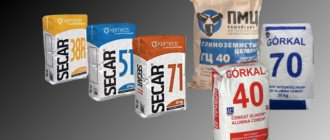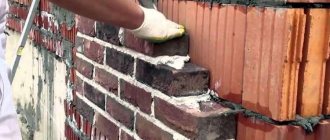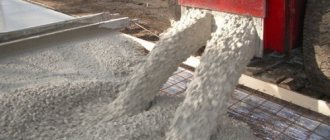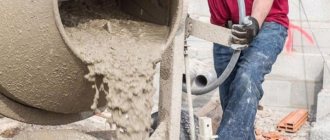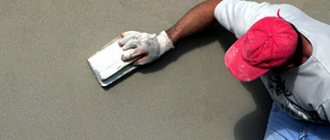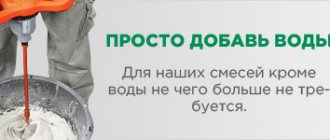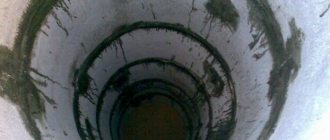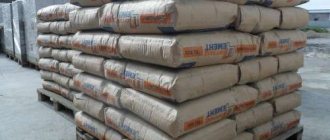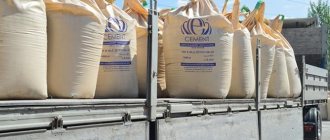- Peculiarities
- Material composition
- Specifications
- Brands and properties
- Where is it used?
- Technology of use
- Marking
- Advantages and disadvantages
In the construction of both high-rise buildings and small buildings, the use of concrete mortar is an important component of correct and competent work. Without it, it is impossible to lay the foundation and screed the floor. Concrete contains cement. It is not resistant to aggressive environments, does not tolerate cold temperatures well, and also has poor water resistance. In addition, cement shrinks strongly.
Tensile cement (“SC”) has become widespread because its use solves the above problems ; the material can be laid in difficult conditions. The main difference between prestressing cement is that as the concrete mixture hardens, it begins to expand. Due to this, low temperatures and the shrinkage process do not harm the structure.
Peculiarities
Portland cement, which is part of concrete, contains gypsum and fine cement clinker. On average, ordinary Portland cement shrinks about 2 mm/m. The full effect can be seen after 2 weeks of using the mixture, when the composition hardens. In the 3rd week there is a risk of cracks appearing.
Tensile cement gives a much faster expansion , which can be observed within 3 days after applying the mixture. That is, in this case, the concrete will harden much faster, which will give additional strength and help preserve it during the “dangerous” period.
Self-expanding cements contain various additives, due to which a similar effect is achieved. The more such impurities, the faster the mixture expands, that is, the composition will harden in a shorter time. However, if there are too many additives, the hardening time can be reduced to 4-5 minutes, which will create additional difficulties in working with the material.
Properties and scope of application of prestressing cement
Ordinary Portland cement, which is part of concrete, is characterized by low water resistance and resistance to frost and aggressive environments. To solve this problem, a special group of compounds called self-expanding or non-shrinking cements was developed. The most prominent representative of this group is tensile cement (SC), which best meets all operational requirements and is suitable for installation in difficult conditions.
A distinctive feature of this composition is that cement of this type begins to increase in volume during the process of hardening of the concrete mass. Thanks to this, shrinkage and frost do not have a detrimental effect on the constructed structure.
Headings Questions
Material composition
Self-expanding compositions are divided into four types - tensile cement (TS), waterproof expansive cement (WRC), aluminous expansive cement (AGRC/GC) and expansive Portland cement (RPC). Most often, prestressing cement is used in construction work. It is a binder mixture and contains about 70 percent Portland cement clinker, up to 10 percent gypsum and up to 20 percent alumina slag.
Its main characteristics are fast setting and high strength. When diluted with water, the mixture sets in a short time. After this, the expansion process occurs. 24 hours after installation, the composition gains strength of about 300 kg/cm3.
In this regard, the material expands and a load appears on reinforced concrete structures. It is important to understand that the characteristics of the mixture may vary depending on its components.
DIRECTIONS FOR USE
For the installation of waterproofing coatings: the surface on which the coating is applied must be durable, without delamination, without greasy stains and dirt. The surface of the fittings should also be free of grease. Before applying the coating, the surface must be moistened. Depending on the requirements for the structure, the waterproofing coating can be made of mortar or concrete. It is not allowed to work under water pressure! To obtain a waterproof cement-sand mortar, it is necessary to mix NC with clean sand in a ratio of 1:2 and mix it with the required amount of water (40% by weight of cement). Apply the solution by torquetting or pneumatic spraying. It is allowed to apply the solution manually as long as the necessary compaction of the mixture is ensured. Concrete is prepared using conventional technology using NC cement instead of Portland cement. The consumption of NC is 450-500 kg per 1 m³ of concrete. The concrete mixture must be thoroughly mixed and thoroughly compacted when laying. The next day after production, the surface of the structure must be moistened. Keep the surface of the structure moist and protect it from drying out for 7 days. Mixing NC cement with other types of cement is not allowed, as it will lose its special properties. The consumption of dry mixture per 1 m² of surface with a layer thickness of 10 mm is 18 kg (NC cement consumption is 20 kg). Shelf life: no more than 6 months in a dry place.
Pickup or delivery. Delivery in Moscow, Moscow region and nearby regions. The warehouse is open day and night.
Specifications
If we draw an analogy with a conventional composition, prestressing cement has a longer service life due to a large number of positive properties. Even currently used modifying fillers cannot always compete with it. Due to this, the use of this mixture is characterized by good reviews of its use.
As for the technical specifications, they can be seen on the back of the package. The initial setting time of the solution must be indicated. It is about 30 minutes. Then comes the flexural strength after 48 hours and after 4 weeks - 3.8 MPa and 5.9 MPa, respectively, and the compressive strength at the same time will be 14 MPa and 49 MPa.
The self-stress indicator is 2 MPa. Frost resistance – F-30. The linear voltage of the solution can range from 0.3 to 1.5 percent.
The packaging also states that work with the composition can be carried out at temperatures from +5 to +35 degrees. Tensile cement is packaged in paper bags of 25 and 45 kilograms.
Price:Cement NTs-10 — 10,500 rub/t (including VAT)Cement NTs-20 — 11,500 rub/t (including VAT)Packaging: 50 kg bags Shipment: from 1000 kg |
Description
Tensile cement NTs (GOST R 56727-2015) is a highly effective binder with waterproofing properties. It is a composition based on finely ground Portland cement clinker, an expanding additive and gypsum. Concretes made using this type of cement, during the period of their hardening under conditions of limited deformation, have the property of self-stress. The use of prestressing cement is due to a number of technical and economic advantages, including ensuring crack resistance and water resistance, reducing the consumption of reinforcement and binders, and reducing the construction and operation time of the facility. The price of prestressing cement, in comparison with Portland cement, is higher, but objective requirements for the reliability of structures generally justify the choice in favor of more efficient materials. Therefore, when repairing and constructing particularly critical areas, experts recommend purchasing prestressing cement.
To achieve these properties, aluminous slag and sulfated clinker are used in the production of cement, which act as an expanding additive, which is one of the main components. Various mineral additives included in the composition, not exceeding 5% of the total mass, are considered auxiliary components, and may vary depending on the scope of application of the final product. In addition, by agreement with the customer, it is permissible to use special and technological additives in the composition, the requirements for which are regulated by GOST 31108. At the same time, additives that increase the hazard class of cement are not allowed to be introduced into prestressing cement.
Tensile cements, depending on the value of self-stress, are divided into four types: low, low, medium and high self-stress energy. In terms of strength, the material is divided into classes 32.5 and 42.5, as well as normal-hardening (N) and rapid-hardening (B) subclasses. In accordance with GOST, the start of setting should occur no earlier than thirty minutes from the moment of mixing. This rule applies to all types of tensile cements.
The material is stored in silos, closed containers (without packaging) or in dry rooms (in packaging). In this case, it is necessary to separate cement into classes and subclasses of strength. It is unacceptable to store prestressing cement without packaging in barn-type warehouses. It is also allowed to store prestressing cement in MKR-type containers with a polyethylene (waterproof) backing, under a canopy or in an open area.
Application
Tensile cement has proven itself to be an effective material in the construction and repair of various structures with high requirements for strength and water resistance. Such objects include water settling tanks, wastewater treatment plants, and various types of reservoirs. Concretes based on prestressing cement are used in the construction and repair of basement floors of buildings, the construction of subway tunnels, bunkers, swimming pools and underground objects exposed to groundwater. In addition, the material has been widely used in the manufacture of pressure and non-pressure pipes, repair and construction of airfield pavements, and construction of radioactive waste repositories.
Characteristics
| Indicator name | Value for cement type | |||
| NTs-10 | NTs-20 | |||
| Linear expansion, %, no more | 1,0 | 1,5 | ||
| Self-stress, MPa (kgf/cm), not less | 0,7 (7) | 2,0 (20) | ||
Brands and properties
The time it takes for cement to harden, as well as what technical characteristics it will have, depends mainly on the proportions of the main components of the material. In order for these points to be fixed and spelled out, the document GOST 31108-2003 appeared. It regulates the proportions of components, which helps to avoid problems and misunderstandings during all construction work.
GOST 31108-2003 divides self-expanding compounds into 3 types:
- The NTs 10 marking is used to mark non-shrinkable compounds;
- NC 20 are considered compounds with medium expansion;
- The brand name NTs 60 is cement with maximum expansion rates.
The choice of a specific type of cement depends on the area of its application, but the NTs 20 brand has gained the widest popularity due to its optimal characteristics and a large number of positive reviews.
The use of NTs 20 helps to achieve a high level of concrete strength. Expansion rates and tensile strength are higher than those of mortars based on ordinary Portland cement. The water pressure withstood by concrete with the addition of NC 20 can reach 20 atmospheres, frost resistance - up to 1500 cycles.
All of the listed characteristics make this type of prestressing cement especially in demand in various types of construction work.
Tensile cement NTs 10
The best representative of expanding binder cements is cement NTs 10
is a fast-hardening, expanding sulfoaluminate cement.
The difference between this cement and ordinary cement is that during the hardening process of cement it increases in volume, which largely neutralizes the effect of shrinkage, and thanks to its dense fine-grained structure with closed pores, mixtures and concretes based on NTs 10
have increased hydro and corrosion resistance, including in sulfate environments.
This tensile cement NTs-10 is used:
■ in the construction of swimming pools, wastewater treatment plants, subway tunnels, roll-free roofing coverings; ■ during reconstruction and repair of flooded or damp premises; ■ during the construction of road and airfield pavements, road bridges, roofs in use, floors of industrial buildings, including food industry enterprises; ■ for the manufacture of pressure and non-pressure pipes; ■ when performing repair work, reconstruction, strengthening of structures, restoring water resistance; ■ when making crack-resistant waterproof joints and seams of all types; ■ in the manufacture of massive prefabricated and monolithic products, structures, including hollow-core floor slabs, structures with prestressed reinforcement.
Expanding cement is the best representative of expanding cementitious building mixtures. Concrete and mortars based on this cement have increased compressive and tensile strength, self-tension and almost complete water resistance, increased frost resistance (up to 1500 cycles) and corrosion resistance, low gas permeability (40 times less than Portland cement), increased resistance to aggressive influences, high adhesion to old concrete. Cement does not form toxic compounds in the air and does not require additional waterproofing.
Please note that prestressing cement requires special care: after mixing, for the first 5-7 days it is necessary to moisten the surface at least once a day, and during the maintenance period it is also necessary to cover the surface with plastic film or other materials that prevent the rapid release of moisture.
Tensile concrete on prestressing cement exerts pressure on obstacles that limit its expansion. The force developed by a mortar or hydraulic concrete while limiting its expansion is a self-stressing force.
Hydrocement NTs 10
is a non-shrink cement. During the expansion process, prestressing cement creates prestress in the reinforcement of reinforced concrete structures. In each prestressed element of a reinforced concrete structure, elastic expansion of the cement stone of the prestressed hydraulic concrete occurs due to the resistance exerted by the reinforcement. The magnitude of this expansion is about 0.5%. In this case, the prestressed reinforcement may experience multiaxial stress.
Cement NTs 10
most effective for the preparation of waterproofing mixtures, prestressed hydraulic concrete and sand concrete for the construction of underground, underwater structures, tanks, pipelines; It is also advisable to use NC prestressing cements during road works, at airfields, for prestressing large structures, in prestressed joints of structural elements, joints of structures under liquid and gas pressure. NC hydraulic cement can also be effective for repairing and strengthening structures. Prestressing cements provide gas-tightness of hydraulic concrete and resistance to chemically aggressive environments.
Where is it used?
Due to the positive characteristics of prestressing cement, its scope of application is quite wide. Its use is relevant in the construction of swimming pools and wastewater treatment plants. Given its resistance to adverse environments, it can be used to create structures subject to significant dynamic loads, as well as objects intended for storing toxic materials. Given its waterproof properties and good adhesion properties to the previous concrete base, this self-expanding composition is often used in the renovation of buildings that are prone to flooding, as well as in the production of pipelines.
When arranging private houses, NTs 20 cement is often used to create fireplaces and heating stoves. In the construction of a bathhouse, garage, and underground premises, this composition will also become an indispensable assistant. For any work that requires resistance to temperature changes or waterproofing, it is also advisable to use prestressing cement. Indispensable for sealing cracks and seams, increases the strength of foundations.
It is important to remember that it is not recommended to mix tensioning and other types of cement, since this will result in the loss of the special properties of NC. The optimal proportions for a good quality solution are NC 20 and river sand. The composition must be mixed 1:2.
Expanding varieties of cement mixtures
Expanding types of cement include a group of cementitious materials that do not shrink or increase in volume during the hardening process. The need for their use arises when it is necessary to obtain crack-resistant coatings, carry out waterproofing and repair work. The ability to expand is achieved through the introduction of a number of additives; as a rule, such compositions are more expensive and have special hardening conditions. Despite all their advantages, these brands are highly specialized; their use must be economically justified.
Description of material
These mixtures are made from aluminous slag, natural gypsum stone (dihydrous or semihydrous), quicklime, aluminum powder or similar additives.
The increase in volume occurs due to the formation of microscopic bubbles or the growth of crystals in the initial minutes of solidification, exclusively under conditions of high humidity (in normal or dry air the ability to expand will not manifest itself; in extreme cases, the solution will remain non-shrinkable).
The time for setting and final strength development depends on the brand: from 4-14 minutes and 14 hours and above; in general, this group of binders has an accelerated time to reach a solid state.
Types and markings
Depending on the composition and properties, the following varieties are distinguished:
- VRC is a waterproof expanding cement characterized by a high hardening rate and increased resistance to moisture. It is used in the restoration and construction of underground and underwater facilities, waterproofing mines and tunnels.
- RC is an expanding Portland cement that hardens quickly when steamed.
- NC is a prestressing cement recommended for concreting structures with multidirectional reinforcement, for example, pressure pipes or thin-walled concrete products. This variety, in turn, is divided into NTs 10 (non-shrinking), NTs 20 (tensioning) and NTs 40 (self-expanding).
- GGRC – gypsum-alumina, intended for the preparation of waterproofing plasters and concrete.
Main characteristics and properties
All of the above types of binders are fast-hardening hydraulic binders, mixed with water and gaining strength in conditions of high humidity. The technical characteristics of cements with such abilities depend on the composition; setting times and other indicators vary among different brands:
| Parameter or property name | WRC | RC (RPC) | NC | GGRC |
| Compound, % | Gypsum-alumina cement – 70, highly basic calcium hydroaluminates – 10, gypsum – 20 | Portland cement clinker – 58-63, slag – 5-7, gypsum – 7-10, hydraulic additive – 20-25 | Portland cement – 65-70, slag – 16-20, gypsum – 14-16 | High-alumina slag – 70, construction gypsum – 30 |
| Start of setting, min | From 4 | Not earlier than 30 | 2-5, extended by adding sulfite-alcohol stillage | At least 20 |
| Final set, strength, h | After 25-28 hours the structure becomes completely waterproof, but maximum brand strength is achieved after 28 days | 65-80, subject to steaming - 30-35 | Up to 28 days | 70-85 |
| Conditions of solidification and operation | Internal expansion lasts a long time, the best results are observed when curing in a very humid environment | Recommended for steaming at temperatures from +60 °C | Characteristics improve with steaming | Warm up when concreting is necessary at sub-zero temperatures; when hardening in air, they require intensive moistening for at least 3 days |
| Ultimate compressive strength, kgf/cm2 | Up to 500 | 400-600 | Up to 600 at NC 40 | Up to 500 |
| Relative linear expansion value, % | 0,02-1 | 0,3-1 | Until 3 | 0,3-1 |
The positive properties of mortars based on expanding and tensile cement include:
- High adhesion, including with metal reinforcement and old building materials.
- Accelerated strength gain - most brands reach 80% of the maximum during the first day; they are recommended to be purchased when work is limited.
- No shrinkage, crack resistance, uniform distribution of solutions inside the cavities.
- Resistance to corrosion, aggressive influences, temperature changes, alkalis and moisture.
- Good compressive strength – up to 600 kgf/cm2.
- Durability.
The disadvantages include narrow specialization and high price; these brands are considered expensive; you should beware of counterfeits. Despite the more complex manufacturing technology compared to conventional Portland cement and a large number of additional components, mixing and applying solutions is not difficult.
Areas of use
The use of such cements is economically feasible when:
1. Construction, repair and reconstruction of hydraulic structures.
2. The need to improve the strength and moisture-repellent characteristics of the building.
3. Manufacturing and restoration of monolithic and prefabricated tanks and reservoirs: swimming pools, water pressure, sewer and treatment systems.
4. Preparation of moisture-proof plaster compositions, including for the purpose of preserving the thermal insulation properties of porous grades of concrete and natural materials (for example, shell rock).
5. Construction and repair of underground structures: tunnels, mines, subways.
6. Construction of coatings in areas with high loads: on bridges and airfields.
7. Gluing reinforced concrete slabs, including during the construction of multi-story buildings.
8. Preparation of non-shrinkable concrete.
9. Construction of sports facilities: from skating rinks to stands and running tracks.
10. Carrying out emergency and emergency work.
The demand for expanding alumina cement in private construction is increasing, despite the high price it is recommended to buy it for waterproofing basements and ground floors, bathhouses, garages and swimming pools. With proper preparation of the base, the consumption of the composition will be low, the use of RC will be justified when it is necessary to create crack-resistant coatings, protect seams and joints.
When working with this material, it is important to ensure the correct application conditions; it should be remembered that its positive properties appear only when it hardens in a humid environment.
Porosity and expansion effect are observed at the slightest contact with water; due to the accelerated setting time, the prepared solution is consumed immediately, all surfaces are prepared in advance.
Important nuances include strict control over the proportion of injected water; violation of manufacturers’ requirements is unacceptable. If all rules are followed, the mixture hardens without cracks, forming a smooth and completely water-impermeable coating.
Cost of materials
| Brand name, manufacturer | Brief description, recommended scope of application | Packaging, kg | Price, rubles |
| NTs 40, Rubin | Dry mixture based on prestressing cement for the production of waterproof plaster mortars and concretes that do not require additional waterproofing. Brands with medium self-tension energy | 25 | 350 |
| NTs 40 expanding, Podolsk | 40 | 540 | |
| NTs 10 non-shrink, Podolsk | A product of joint grinding of aluminous slag of Portland cement and gypsum, used for concreting swimming pools, tunnels, floors, existing roofs, sealing seams, repair and restoration work | 20 | 350 |
| GGRC, Pashiysky MCZ | Expanding gypsum-alumina cement based on finely ground blast furnace slag and gypsum stone. Used in subway construction, construction of liquid fuel storage tanks, caulking of pipes and joints, arrangement and repair of swimming pools and showers | 50 | 1400 |
| ROC-20 M500, Podolsk | Expanding fast-hardening Portland cement. RC is designed for waterproofing work during water inflow | 50 | 4900 |
| VRC, Pashiysky MCP | Waterproof, expansive cement with high setting speed (from 4 minutes). Due to its exceptional characteristics it has a limited scope of application | 40 | 700 |
Technology of use
To obtain the greatest effect when using prestressing cement, the entire area where it will be used must be carefully prepared. Joints and surfaces must be thoroughly washed and degreased, and the walls of the formwork must be moistened.
The list of items required when using the composition is quite extensive. It is necessary to prepare special clothing in which the work will be carried out. You will also need: a container in which the solution will be mixed, a shovel, rags, high-frequency vibrators for concrete and a triangular trowel for applying cement.
First, the composition itself is prepared. Sifted river sand is mixed with cement in a 2:1 ratio and filled with water to approximately 40 percent of the mass of the powder. After the composition is thoroughly mixed to a homogeneous consistency, it is poured into the formwork or used to seal seams, cracks and joints. After the composition is applied, it must be properly compacted and left for 24 hours. After this, the surface is moistened for another week.
Marking
All types of cement must be marked. This is done so that it is clear what composition can be used and for what purpose. Includes numbers and letters.
Until 2003, GOST 101785 was used. Its designations included the type of mixture, its strength, as well as the presence of mineral additives, which was indicated as a percentage. At the end, additional properties were noted.
According to the currently valid GOST 31108, the marking has changed slightly, but for the convenience of buyers, both options are still mostly used on the packaging. In the new labeling, the composition comes first (I – with no additives, II – with additives). Mixtures with additives are divided according to their quantity, the letter “A” indicates the presence of from 6 to 20 percent of impurities, the letter “B” - from 21 to 35 percent. Roman numerals indicate what type of additives are used in the mixture.
Next, the numbers indicate the strength limits - from 22.5 to 52.5 MPa , and the compression rates of the material, which range from 2 to 7 days and are designated by the letters: “N” - normal-hardening, “C” - medium-hardening, “B” - fast-hardening composition. The most actively used, given its properties, is cement grade 32.5N. M500 is suitable for specialized facilities, as it is particularly reliable and has a longer service life.
Advantages and disadvantages
According to the experience of professionals, tensile cement has many more advantages than disadvantages.
- For example, it is not subject to shrinkage, which has a beneficial effect on the strength of objects, sets quickly, is resistant to negative environmental influences and external pressure, and has properties such as water resistance, resistance to low temperatures, fire safety, and waterproofing.
- The operating time of objects when using this mixture increases several times.
There are also negative aspects.
- One of them is the fairly high cost of this material. But this is more than compensated by the durability of the buildings.
- In addition, when the temperatures that concrete is often exposed to are too low, the prestressing cement may lose some of its properties. It would also be a good idea to check the certificate of conformity of the purchased product to avoid possible counterfeits.
You can learn how to properly mix cement mortar from the following video.

